MarketCamp, a Mexico City start-up, offers high-quality traffic generation and lead closures for local internet businesses. Our services include detailed research, internet targeting, mini-site development, search engine submissions, and statistical reporting.
Our primary market is Mexico City’s business community. While we can serve relatively small businesses for $1,000 per month, we can also scale up to meet the needs of larger clients. Mexico’s internet connection is currently lower than the US’s, but interest is growing. Despite being behind major industrial countries, Mexico has a rapidly growing internet population with thousands of users and websites. CompuServe Mexico has 30,000 subscribers, while Spin Internet boasts 28,000 Mexican members.
MarketCamp has a competitive advantage due to our experience and market expertise. Founder Paul Berry spent five years in the US, honing his e-business skills. With an MBA from the University of Oregon and previous work at Forrester Research, a premier internet marketing research company, Paul brings valuable experience and insight to MarketCamp.
We have conservative sales projections, expecting sales to more than double by year three. Profitability will be achieved by year one, and our profit margin will steadily increase from year one to year three.
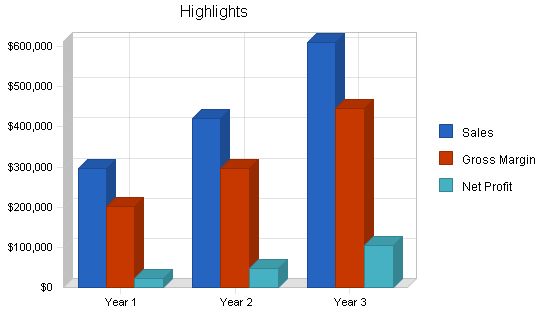
Contents
1.1 Objectives
The objectives for the company are:
- To be self-sufficient within three months.
- To achieve healthy sales in Year 1, steadily growing in Year 2 and Year 3.
1.2 Mission
MarketCamp will provide full-service Internet marketing campaigns, focusing on keyword combination search results, targeted advertising, and mini-sites that deliver offers in a clean, statistically monitored environment.
1.3 Keys to Success
- Keep existing clients to develop repeat business.
- Clients must make money and know it.
- Start with easily demonstrable simple modules and build up from there.
Company Summary
MarketCamp is a Web marketing business based in Mexico City. The company will start as a simple consulting business billing directly in the founder’s name.
2.1 Company Ownership
This company is 100% owned by its founder, Paul Berry.
2.2 Start-up Summary
Start-up costs are detailed in the chart and table below.
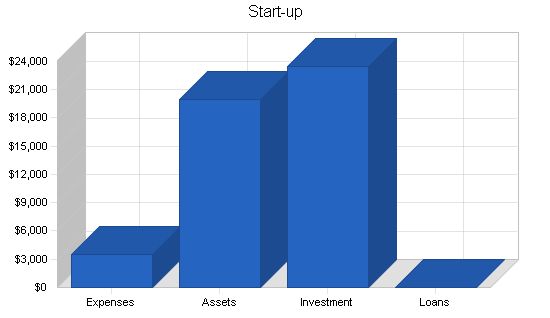
Start-up Funding:
Start-up Expenses to Fund: $3,500
Start-up Assets to Fund: $20,000
Total Funding Required: $23,500
Assets:
Non-cash Assets from Start-up: $0
Cash Requirements from Start-up: $20,000
Additional Cash Raised: $0
Cash Balance on Starting Date: $20,000
Total Assets: $20,000
Liabilities and Capital:
Liabilities:
Current Borrowing: $0
Long-term Liabilities: $0
Accounts Payable (Outstanding Bills): $0
Other Current Liabilities (interest-free): $0
Total Liabilities: $0
Capital:
Planned Investment:
Paul Berry: $23,500
Other: $0
Additional Investment Requirement: $0
Total Planned Investment: $23,500
Loss at Start-up (Start-up Expenses): ($3,500)
Total Capital: $20,000
Total Capital and Liabilities: $20,000
Total Funding: $23,500
Start-up Requirements:
Start-up Expenses:
Legal: $1,000
Stationery etc.: $1,000
Brochures: $1,000
Insurance: $500
Other: $0
Total Start-up Expenses: $3,500
Start-up Assets:
Cash Required: $20,000
Other Current Assets: $0
Long-term Assets: $0
Total Assets: $20,000
Total Requirements: $23,500
2.3 Company Locations and Facilities:
MarketCamp will begin as a home-office business in the founder’s apartment in Mexico City. After six months of operation, it will expand to a formal office space in Mexico City.
Services:
– Detailed Research.
– Internet Targeting Proposal.
– Focused Mini-Site Development.
– Top Search Results on Keywords.
– Advertising Creative Design.
– Monthly Statistical Reporting.
– Campaign Maintenance.
3.1 Service Description:
**Details and a description of services have been omitted from this published plan because they were strategic and proprietary.
3.2 Competitive Comparison:
Competition isn’t the most important factor at this time. There is plenty of need and potential customers out there.
3.3 Sales Literature:
Our website will serve as sales literature.
3.4 Fulfillment:
For the present time, until there is real growth, services will be delivered by the founder.
3.5 Technology:
**Details have been omitted from this published plan because they were strategic and proprietary.
3.6 Future Services:
**Details have been omitted from this published plan because they were strategic and proprietary.
Market Analysis Summary:
Mexico City’s business community will be the primary market for our company. We will attempt to work with business models that attract customers and sign contracts. The business size can be relatively small because the cost per month is only $1,000, but services can be scaled up to meet the needs of huge clients due to the focus and expertise of the business.
Internet connectivity in Mexico, in comparison with the U.S., is currently low, but interest is growing. Though far behind the major industrial countries, Mexico maintains one of the fastest growth rates on the Internet with thousands of users and thousands of WWW sites. Mexican WWW sites have been growing at the rate of 200-300 per month this year. CompuServe Mexico, the largest commercial Internet service provider in Mexico has 30,000 subscribers, while Spin Internet has 28,000 Mexican members. Microsoft Mexico, a division of Microsoft’s recently-launched online service named Microsoft Network, will charge $4.95 per month (about one half of CompuServe’s $9.95 per month rate) and will offer local telephone access in Mexico City, Guadalajara, Monterrey, and three other cities. The service will be English-only and U.S.-oriented for at least the first six months, but will eventually include local content.
Many companies in Mexico City currently have Internet access and more are realizing the importance of presence on the Web to attract international business. For this reason, our Market Analysis table predicts rapid growth amongst potential small businesses and marketing managers for medium-sized businesses to grow in-line with the growth of Internet usage.
We will try to work with other more established marketing companies, giving up some of the margin to get access to more clients quickly.
We will need to make a decision on pricing, whether to keep rates at an attractive sign-up rate or focus on the more successful clients and raise rates.
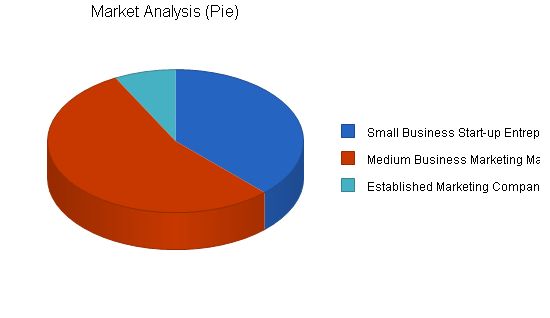
Market Analysis
Potential Customers Growth Year 1 Year 2 Year 3 Year 4 Year 5 CAGR
Small Business Start-up Entrepreneurs 100% 475 950 1,900 3,800 7,600 100.00%
Medium Business Marketing Managers 80% 684 1,231 2,216 3,989 7,180 80.00%
Established Marketing Companies 20% 97 116 139 167 200 19.83%
Total 85.84% 1,256 2,297 4,255 7,956 14,980 85.84%
Strategy and Implementation Summary
We will obtain our first clients through word-of-mouth from the board of directors, advisors, and Paul Berry’s freelance business connections. Each mini-site will feature a small “powered by MarketCamp” logo linking to information about us. Due to the quality of our work and expertise, we expect to gain more clients in the near future.
Competitive Edge
MarketCamp’s strongest competitive edge is our expertise in a complicated field. Our founder has extensive experience in obtaining high click-through rates and top search engine placement. As Mexico City lags behind the American Internet by three to five years, our founder’s expertise gives us a significant advantage. We will be the first to introduce this service to the market, positioning us years ahead of competitors.
To develop effective business strategies, perform a SWOT analysis. Our free guide and template can assist you in conducting a SWOT analysis.
Sales Strategy
The subscription model and commission-based earnings are the beauty of this business. Once we acquire a client, most will remain with us for a long period, potentially for the lifetime of the business. We believe that 30% to 60% growth rates are conservative, allowing us to potentially acquire clients at a rapid pace.
We anticipate a conservative growth rate of 30% to 60% in the first year. If we attract more clients than expected, we can quickly expand our team to meet demand. The founder, along with a network of top programmers, will develop the back-end of the business.
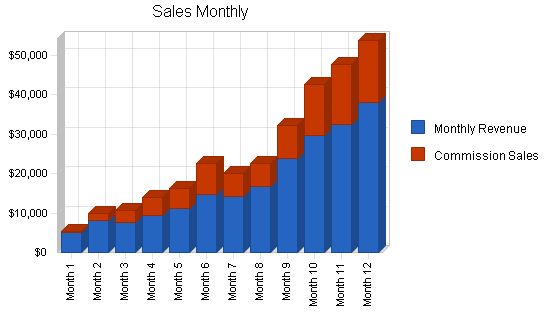
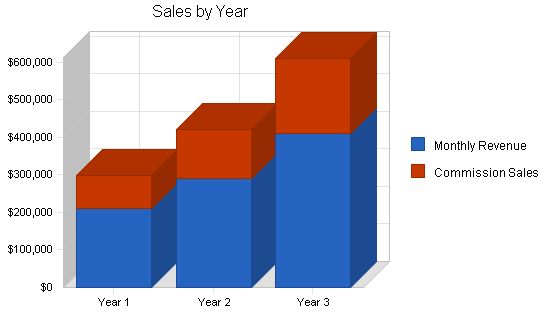
Sales Forecast:
Sales:
Year 1 Year 2 Year 3
$210,550 $290,000 $410,000
Commission Sales:
Year 1 Year 2 Year 3
$86,760 $130,000 $200,000
Total Sales:
Year 1 Year 2 Year 3
$297,310 $420,000 $610,000
Direct Cost of Sales:
Year 1 Year 2 Year 3
$39,831 $54,860 $77,561
Commission Sales:
Year 1 Year 2 Year 3
$17,352 $26,000 $40,000
Subtotal Direct Cost of Sales:
Year 1 Year 2 Year 3
$57,183 $80,860 $117,561
5.4 Milestones:
The specific milestones are shown in the following chart and table.
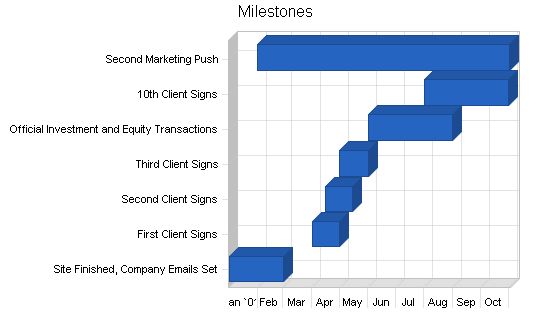
Milestones:
Site Finished, Company Emails Set
Start Date: 1/1/2001
End Date: 3/1/2001
Budget: $0
Manager: Paul Berry
Department: Founder
First Client Signs
Start Date: 4/1/2001
End Date: 4/30/2001
Budget: $0
Manager: Paul Berry
Department: Founder
Second Client Signs
Start Date: 4/15/2001
End Date: 5/15/2001
Budget: $0
Manager: Paul Berry
Department: Founder
Third Client Signs
Start Date: 5/1/2001
End Date: 6/1/2001
Budget: $0
Manager: Paul Berry
Department: Founder
Official Investment and Equity Transactions
Start Date: 6/1/2001
End Date: 8/31/2001
Budget: $0
Manager: Paul Berry
Department: Founder
10th Client Signs
Start Date: 8/1/2001
End Date: 10/31/2001
Budget: $0
Manager: Paul Berry
Department: Founder
Second Marketing Push
Start Date: 11/1/2001
End Date: 1/31/2001
Budget: $0
Manager: Paul Berry
Department: Founder
Totals: $0
Management Summary:
Paul Berry will be the president, responsible for all hiring and expenses decision-making. Paul will also establish a system for future employees to scale the business.
Carlos Silva will be an investor, possibly also a co-founder and a board member.
Gabriela Lopez will be a part-time employee, responsible for design and web knowledge.
Raul Garcia will be a part-time employee, responsible for sales and junior executive tasks in Mexico City.
6.1 Personnel Plan:
Paul will initially be paid $3,000 to $5,000 per month, depending on the number and nature of client contracts.
Gabriela Lopez will be contracted for $1,000 to $2,000 depending on workload and availability. She will handle corporate identity, stationery, and brochure design.
Raul Garcia will be contracted for $1,000 to $2,000 depending on involvement and will receive commissions for additional clients.
Personnel Plan:
Year 1 Year 2 Year 3
Paul Berry $43,000 $60,000 $75,000
Commission $17,352 $26,000 $40,000
Programmers $19,900 $27,000 $43,000
Total People 0 0 0
Total Payroll $80,252 $113,000 $158,000
6.2 Management Team:
**Details have been omitted from this published plan because they were strategic and proprietary.
6.3 Management Team Gaps:
**Details have been omitted from this published plan because they were strategic and proprietary.
MarketCamp will finance growth mainly through cash flow, recognizing the need for slower growth.
The most crucial factor for our success is collection days. Pushing hard for payment is challenging as our clients have marketing authority, not financial authority. Thus, we need a system of receivables financing through an established financial company.
We assume start-up capital will cover salaries, artwork, and expenses while the business generates more cash.
We may seek additional financing to attract equity partners with connections to potential clients in Mexico City.
7.1 Important Assumptions:
The Financial Plan depends on several assumptions outlined in the annual assumptions table. Collection days, interest rates, tax rates, and personnel burden are conservatively estimated.
Some important assumptions include:
– A slightly crippled economy due to the George W. Bush administration and skepticism from failed dot-coms
– Effective communication of services to Mexican business owners
General Assumptions:
Year 1 Year 2 Year 3
Plan Month 1 2 3
Current Interest Rate 10.00% 10.00% 10.00%
Long-term Interest Rate 10.00% 10.00% 10.00%
Tax Rate 25.42% 25.00% 25.42%
Other 0 0 0
7.2 Key Financial Indicators:
The Benchmarks chart presents our projections for key financial indicators on an index basis.
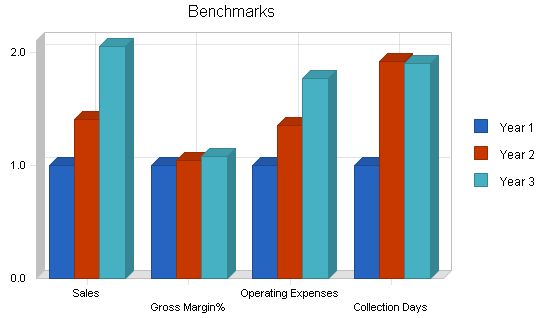
The chart and table below summarize our break-even analysis, indicating fixed costs in U.S. dollars per month and the necessary billing amount to cover these costs. We anticipate achieving break-even several months after starting the business.
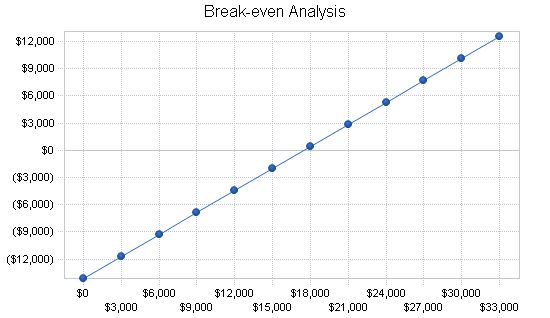
Break-even Analysis:
| Break-even Analysis | |
| Monthly Revenue Break-even | $17,510 |
| Assumptions: | |
| Average Percent Variable Cost | 19% |
| Estimated Monthly Fixed Cost | $14,142 |
7.4 Projected Profit and Loss
The projected profit and loss are shown in the table and charts below.

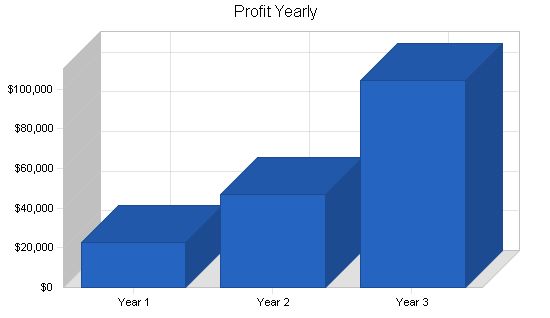
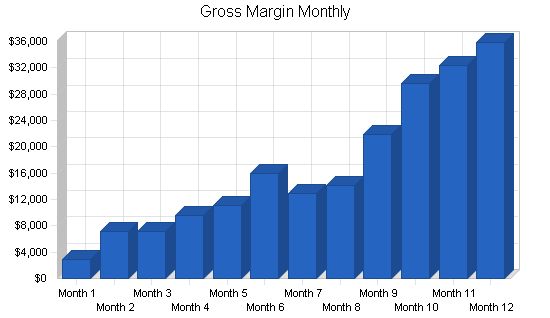
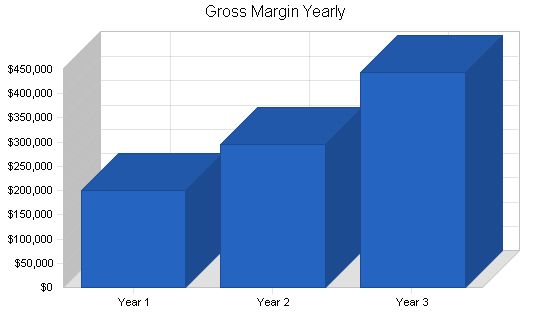
Pro Forma Profit and Loss
Year 1 Year 2 Year 3
Sales $297,310 $420,000 $610,000
Direct Cost of Sales $57,183 $80,860 $117,561
Other $39,581 $44,000 $48,000
Total Cost of Sales $96,763 $124,860 $165,561
Gross Margin $200,547 $295,140 $444,439
Gross Margin % 67.45% 70.27% 72.86%
Expenses
Payroll $80,252 $113,000 $158,000
Sales and Marketing and Other Expenses $41,372 $48,000 $61,000
Depreciation $0 $0 $0
Leased Equipment $15,832 $17,000 $19,000
Utilities $1,800 $2,000 $2,000
Insurance $2,400 $3,000 $3,000
Rent $12,000 $24,000 $26,000
Payroll Taxes $16,050 $22,600 $31,600
Other $0 $0 $0
Total Operating Expenses $169,707 $229,600 $300,600
Profit Before Interest and Taxes $30,840 $65,540 $143,839
EBITDA $30,840 $65,540 $143,839
Interest Expense $667 $3,000 $3,500
Taxes Incurred $7,420 $15,635 $35,669
Net Profit $22,753 $46,905 $104,669
Net Profit/Sales 7.65% 11.17% 17.16%
7.5 Projected Cash Flow
Cash flow relies on accounts receivable collection and payment times. Carlos Silva, Raul Garcia, and others with experience in Mexican businesses will estimate these times. We assume a collection period of 30 days. Clients will typically pay at the beginning of each month, except when unable to do so.
This cash flow projection assumes salary sacrifices as equity contributions in the early months. The capital input is primarily "sweat equity" from the founder.
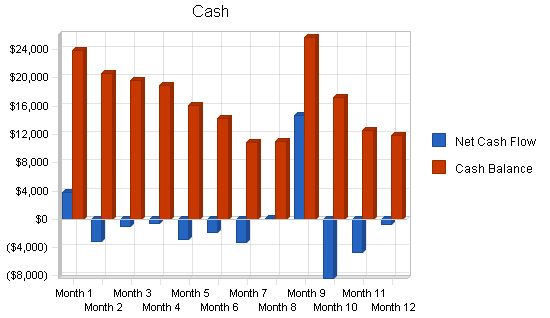
Pro Forma Cash Flow:
Cash Received:
– Cash from Operations
– Cash Sales: $0
– Cash from Receivables: $197,360 (Year 1), $378,754 (Year 2), $546,126 (Year 3)
– Subtotal Cash from Operations: $197,360 (Year 1), $378,754 (Year 2), $546,126 (Year 3)
Additional Cash Received:
– Sales Tax, VAT, HST/GST Received: $0
– New Current Borrowing: $20,000 (Year 1), $40,000 (Year 2), $0 (Year 3)
– New Other Liabilities (interest-free): $0
– New Long-term Liabilities: $0
– Sales of Other Current Assets: $0
– Sales of Long-term Assets: $0
– New Investment Received: $14,000 (Year 1), $0 (Year 2), $0 (Year 3)
– Subtotal Cash Received: $231,360 (Year 1), $418,754 (Year 2), $546,126 (Year 3)
Expenditures:
– Expenditures from Operations:
– Cash Spending: $80,252 (Year 1), $113,000 (Year 2), $158,000 (Year 3)
– Bill Payments: $159,263 (Year 1), $273,759 (Year 2), $340,161 (Year 3)
– Subtotal Spent on Operations: $239,515 (Year 1), $386,759 (Year 2), $498,161 (Year 3)
Additional Cash Spent:
– Sales Tax, VAT, HST/GST Paid Out: $0
– Principal Repayment of Current Borrowing: $0 (Year 1), $20,000 (Year 2), $10,000 (Year 3)
– Other Liabilities Principal Repayment: $0
– Long-term Liabilities Principal Repayment: $0
– Purchase Other Current Assets: $0
– Purchase Long-term Assets: $0
– Dividends: $0
– Subtotal Cash Spent: $239,515 (Year 1), $406,759 (Year 2), $508,161 (Year 3)
Net Cash Flow: ($8,155) (Year 1), $11,995 (Year 2), $37,965 (Year 3)
Cash Balance: $11,845 (Year 1), $23,840 (Year 2), $61,805 (Year 3)
Projected Balance Sheet:
Pro Forma Balance Sheet:
Assets:
– Current Assets:
– Cash: $11,845 (Year 1), $23,840 (Year 2), $61,805 (Year 3)
– Accounts Receivable: $99,950 (Year 1), $141,196 (Year 2), $205,070 (Year 3)
– Other Current Assets: $0
– Total Current Assets: $111,795 (Year 1), $165,036 (Year 2), $266,875 (Year 3)
– Long-term Assets:
– Long-term Assets: $0
– Accumulated Depreciation: $0
– Total Long-term Assets: $0
– Total Assets: $111,795 (Year 1), $165,036 (Year 2), $266,875 (Year 3)
Liabilities and Capital:
– Current Liabilities:
– Accounts Payable: $35,041 (Year 1), $21,378 (Year 2), $28,548 (Year 3)
– Current Borrowing: $20,000 (Year 1), $40,000 (Year 2), $30,000 (Year 3)
– Other Current Liabilities: $0
– Subtotal Current Liabilities: $55,041 (Year 1), $61,378 (Year 2), $58,548 (Year 3)
– Long-term Liabilities: $0
– Total Liabilities: $55,041 (Year 1), $61,378 (Year 2), $58,548 (Year 3)
– Paid-in Capital: $37,500 (Year 1), $37,500 (Year 2), $37,500 (Year 3)
– Retained Earnings: ($3,500) (Year 1), $19,253 (Year 2), $66,158 (Year 3)
– Earnings: $22,753 (Year 1), $46,905 (Year 2), $104,669 (Year 3)
– Total Capital: $56,753 (Year 1), $103,658 (Year 2), $208,327 (Year 3)
– Total Liabilities and Capital: $111,795 (Year 1), $165,036 (Year 2), $266,875 (Year 3)
Net Worth: $56,753 (Year 1), $103,658 (Year 2), $208,327 (Year 3)
Ratio Analysis:
Sales Growth: 0.00% (Year 1), 41.27% (Year 2), 45.24% (Year 3), Industry Profile: 8.60%
Percent of Total Assets:
– Accounts Receivable: 89.40% (Year 1), 85.55% (Year 2), 76.84% (Year 3), Industry Profile: 24.40%
– Other Current Assets: 0.00% (Year 1), 0.00% (Year 2), 0.00% (Year 3), Industry Profile: 46.70%
– Total Current Assets: 100.00% (Year 1), 100.00% (Year 2), 100.00% (Year 3), Industry Profile: 74.90%
– Long-term Assets: 0.00% (Year 1), 0.00% (Year 2), 0.00% (Year 3), Industry Profile: 25.10%
– Total Assets: 100.00% (Year 1), 100.00% (Year 2), 100.00% (Year 3), Industry Profile: 100.00%
Current Liabilities:
– Accounts Payable: 49.23% (Year 1), 37.19% (Year 2), 21.94% (Year 3), Industry Profile: 42.80%
– Long-term Liabilities: 0.00% (Year 1), 0.00% (Year 2), 0.00% (Year 3), Industry Profile: 17.20%
– Total Liabilities: 49.23% (Year 1), 37.19% (Year 2), 21.94% (Year 3), Industry Profile: 60.00%
– Net Worth: 50.77% (Year 1), 62.81% (Year 2), 78.06% (Year 3), Industry Profile: 40.00%
Percent of Sales:
– Sales: 100.00% (Year 1), 100.00% (Year 2), 100.00% (Year 3), Industry Profile: 100.00%
– Gross Margin: 67.45% (Year 1), 70.27% (Year 2), 72.86% (Year 3), Industry Profile: 0.00%
– Selling, General & Administrative Expenses: 59.84% (Year 1), 59.10% (Year 2), 55.60% (Year 3), Industry Profile: 83.50%
– Advertising Expenses: 1.01% (Year 1), 1.43% (Year 2), 2.46% (Year 3), Industry Profile: 1.20%
– Profit Before Interest and Taxes: 10.37% (Year 1), 15.60% (Year 2), 23.58% (Year 3), Industry Profile: 2.60%
Main Ratios:
Current: 2.03 (Year 1), 2.69 (Year 2), 4.56 (Year 3), Industry Profile: 1.59
Quick: 2.03 (Year 1), 2.69 (Year 2), 4.56 (Year 3), Industry Profile: 1.26
Total Debt to Total Assets: 49.23% (Year 1), 37.19% (Year 2), 21.94% (Year 3), Industry Profile: 60.00%
Pre-tax Return on Net Worth: 53.17% (Year 1), 60.33% (Year 2), 67.36% (Year 3), Industry Profile: 4.40%
Pre-tax Return on Assets: 26.99% (Year 1), 37.89% (Year 2), 52.59% (Year 3), Industry Profile: 10.90%
Additional Ratios:
Net Profit Margin: 7.65% (Year 1), 11.17% (Year 2), 17.16% (Year 3), n.a.
Return on Equity: 40.09% (Year 1), 45.25% (Year 2), 50.24% (Year 3), n.a.
Activity Ratios:
Accounts Receivable Turnover: 2.97
Collection Days: 54 (Year 1), 105 (Year 2), 104 (Year 3)
Accounts Payable Turnover: 5.55
Payment Days: 27 (Year 1), 40 (Year 2), 26 (Year 3)
Total Asset Turnover: 2.66 (Year 1), 2.54 (Year 2), 2.29 (Year 3)
Debt Ratios:
Debt to Net Worth: 0.97 (Year 1), 0.59 (Year 2), 0.28 (Year 3), n.a.
Current Liab. to Liab.: 1.00 (Year 1), 1.00 (Year 2), 1.00 (Year 3), n.a.
Liquidity Ratios:
Net Working Capital: $56,753 (Year 1), $103,658 (Year 2), $208,327 (Year 3), n.a.
Interest Coverage: 46.26 (Year 1), 21.85 (Year 2), 41.10 (Year 3), n.a.
Additional Ratios:
Assets to Sales: 0.38 (Year 1), 0.39 (Year 2), 0.44 (Year 3), n.a.
Current Debt/Total Assets: 49% (Year 1), 37% (Year 2), 22% (Year 3), n.a.
Acid Test: 0.22 (Year 1), 0.39 (Year 2), 1.06 (Year 3), n.a.
Sales/Net Worth: 5.24 (Year 1), 4.05 (Year 2), 2.93 (Year 3), n.a.
Dividend Payout: 0.00, n.a.
Appendix:
Personnel Plan:
– Paul Berry: $0 (Month 1), $3,000 (Month 2-4), $3,000 (Month 5-12)
– Commission: $0 (Month 1), $50 (Month 2), $400 (Month 3), $623 (Month 4), $911 (Month 5), $1,019 (Month 6), $1,559 (Month 7), $1,163 (Month 8-9), $1,703 (Month 10), $2,547 (Month 11), $3,035 (Month 12)
– Programmers: $0 (Month 1-4), $1,200 (Month 5), $1,400 (Month 6), $1,800 (Month 7), $2,500 (Month 8), $3,000 (Month 9-10), $3,300 (Month 11), $3,700 (Month 12)
– Total People: 0 (Month 1-4), 1 (Month 5-12)
Total Payroll: $3,050 (Month 1), $3,400 (Month 2), $3,623 (Month 3), $3,911 (Month 4), $5,219 (Month 5), $5,959 (Month 6), $6,963 (Month 7), $7,663 (Month 8), $8,703 (Month 9), $9,547 (Month 10), $10,335 (Month 11), $11,879 (Month 12)
General Assumptions:
– Current Interest Rate: 10.00% (Month 1-12)
– Long-term Interest Rate: 10.00% (Month 1-12)
– Tax Rate: 30.00% (Month 1), 25.00% (Month 2-12)
– Other: 0 (Month 1-12)
| Pro Forma Profit and Loss | |||||||||||||
| Month 1 | Month 2 | Month 3 | Month 4 | Month 5 | Month 6 | Month 7 | Month 8 | Month 9 | Month 10 | Month 11 | Month 12 | ||
| Sales | $5,250 | $10,000 | $10,650 | $13,890 | $16,230 | $22,530 | $20,050 | $22,450 | $32,250 | $42,470 | $47,710 | $53,830 | |
| Direct Cost of Sales | $1,300 | $1,600 | $2,063 | $2,639 | $3,093 | $4,047 | $4,149 | $4,746 | $6,003 | $7,707 | $9,227 | $10,609 | |
| Other | 10% | $1,000 | $1,200 | $1,440 | $1,728 | $2,074 | $2,488 | $2,986 | $3,583 | $4,300 | $5,160 | $6,192 | $7,430 |
| Total Cost of Sales | $2,300 | $2,800 | $3,503 | $4,367 | $5,166 | $6,536 | $7,135 | $8,329 | $10,303 | $12,867 | $15,418 | $18,039 | |
| Gross Margin | $2,950 | $7,200 | $7,147 | $9,523 | $11,064 | $15,994 | $12,915 | $14,121 | $21,947 | $29,603 | $32,292 | $35,791 | |
| Gross Margin % | 56.19% | 72.00% | 67.11% | 68.56% | 68.17% | 70.99% | 64.41% | 62.90% | 68.05% | 69.70% | 67.68% | 66.49% | |
| Expenses | |||||||||||||
| Payroll | $3,050 | $3,400 | $3,623 | $3,911 | $5,219 | $5,959 | $6,963 | $7,663 | $8,703 | $9,547 | $10,335 | $11,879 | |
| Sales and Marketing and Other Expenses | $1,000 | $1,175 | $1,393 | $1,663 | $2,001 | $2,422 | $2,950 | $3,610 | $4,439 | $5,481 | $6,792 | $8,445 | |
| Depreciation | $0 | $0 | $0 | $0 | $0 | $0 | $0 | $0 | $0 | $0 | $0 | $0 | |
| Leased Equipment | 10% | $400 | $480 | $576 | $691 | $829 | $995 | $1,194 | $1,433 | $1,720 | $2,064 | $2,477 | $2,972 |
| Utilities | 10% | $150 | $150 | $150 | $150 | $150 | $150 | $150 | $150 | $150 | $150 | $150 | $150 |
| Insurance | 10% | $200 | $200 | $200 | $200 | $200 | $200 | $200 | $200 | $200 | $200 | $200 | $200 |
| Rent | 10% | $0 | $0 | $0 | $0 | $0 | $0 | $2,000 | $2,000 | $2,000 | $2,000 | $2,000 | $2,000 |
| Payroll Taxes | 20% | $610 | $680 | $725 | $782 | $1,044 | $1,192 | $1,393 | $1,533 | $1,741 | $1,909 | $2,067 | $2,376 |
| Total Operating Expenses | $5,410 | $6,085 | $6,666 | $7,398 | $9,443 | $10,919 | $14,850 | $16,589 | $18,953 | $21,351 | $24,021 | $28,022 | |
| Profit Before Interest and Taxes | ($2,460) | $1,115 | $481 | $2,125 | $1,621 | $5,076 | ($1,935) | ($2,469) | $2,995 | $8,252 | $8,271 | $7,769 | |
| EBITDA | ($2,460) | $1,115 | $481 | $2,125 | $1,621 | $5,076 | ($1,935) | ($2,469) | $2,995 | $8,252 | $8,271 | $7,769 | |
| Interest Expense | $0 | $0 | $0 | $0 | $0 | $0 | $0 | $0 | $167 | $167 | $167 | $167 | |
| Taxes Incurred | ($738) | $279 | $120 | $531 | $405 | $1,269 | ($484) | ($617) | $707 | $2,021 | $2,026 | $1,900 | |
| Net Profit | ($1,722) | $836 | $361 | $1,594 | $1,216 | $3,807 | ($1,451) | ($1,851) | $2,121 | $6,064 | $6,078 | $5,701 | |
| Net Profit/Sales | -32.80% | 8.36% | 3.39% | 11.48% | 7.49% | 16.90% | -7.24% | -8.25% | 6.58% | 14.28% | 12.74% | 10.59% | |
| Pro Forma Cash Flow | |||||||||||||
| Month 1 | Month 2 | Month 3 | Month 4 | Month 5 | Month 6 | Month 7 | Month 8 | Month 9 | Month 10 | Month 11 | Month 12 | ||
| Cash from Operations | |||||||||||||
| Cash Sales | $0 | $0 | $0 | $0 | $0 | $0 | $0 | $0 | $0 | $0 | $0 | $0 | |
| Cash from Receivables | $0 | $175 | $5,408 | $10,022 | $10,758 | $13,968 | $16,440 | $
Pro Forma Balance Sheet |
|||||
| Assets |
| Starting Balances |
| Current Assets |
| Cash |
| Accounts Receivable |
| Other Current Assets |
| Total Current Assets |
| Long-term Assets |
| Long-term Assets |
| Accumulated Depreciation |
| Total Long-term Assets |
| Total Assets |
| Liabilities and Capital |
| Current Liabilities |
| Accounts Payable |
| Current Borrowing |
| Other Current Liabilities |
| Subtotal Current Liabilities |
| Long-term Liabilities |
| Total Liabilities |
| Paid-in Capital |
| Retained Earnings |
| Earnings |
| Total Capital |
| Total Liabilities and Capital |
| Net Worth |
Sales Forecast
| Sales |
| Monthly Revenue |
| Commission Sales |
| Total Sales |
| Direct Cost of Sales |
| Monthly Revenue |
| Commission Sales |
| Subtotal Direct Cost of Sales |
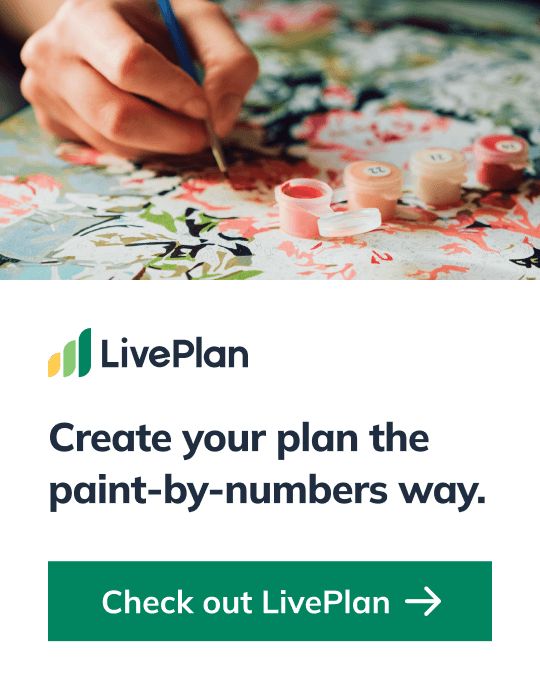
Business Plan Outline
- Executive Summary
- Company Summary
- Services
- Market Analysis Summary
- Strategy and Implementation Summary
- Management Summary
- Financial Plan
- Appendix
Hello!
I’m Andrew Brooks, a seasoned finance consultant from the USA and the mind behind phonenumber247.com.
My career is built on a foundation of helping individuals and businesses thrive financially in an ever-changing economic landscape. At phonenumber247.com, my aim is to demystify the complex world of finance, providing clear, actionable advice that can help you navigate your financial journey with confidence. Whether it’s personal finance management, investment strategies, or understanding the nuances of market dynamics, I’m here to share insights and tools that can propel you towards your financial goals.
Welcome to my digital space, where every piece of advice is a step closer to financial clarity and success!
